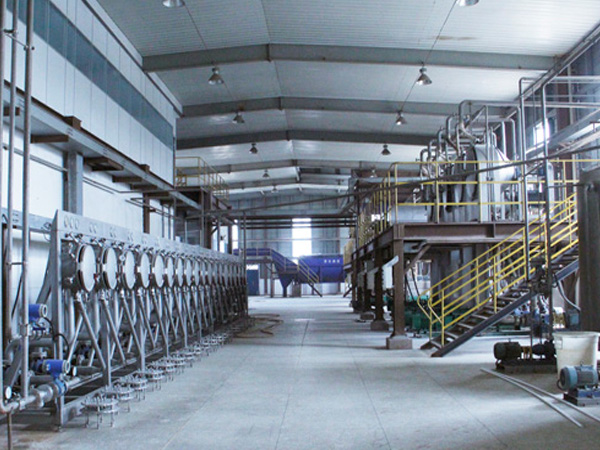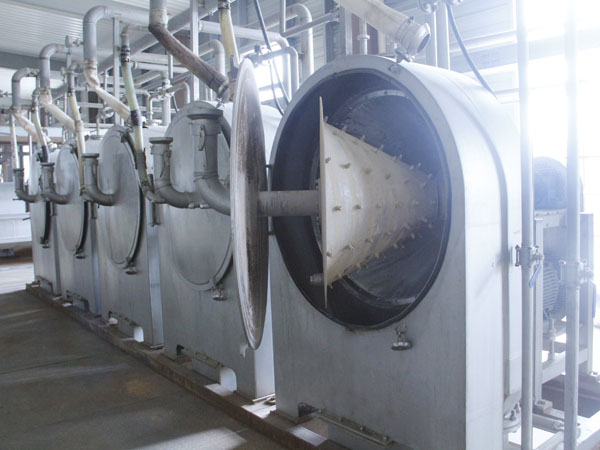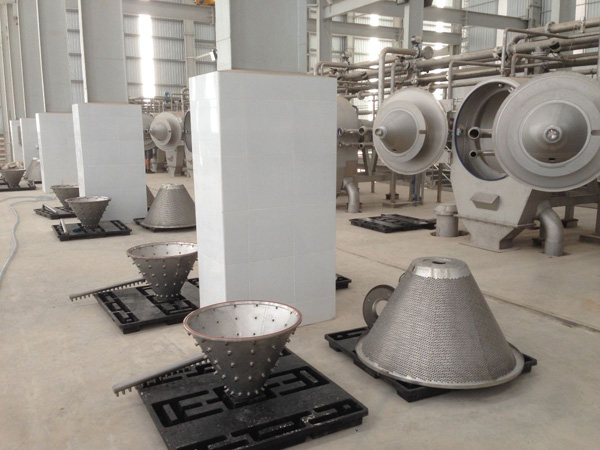Process for preparation of starch from cassava
1. Overview:
The process for preparation of starch from cassava is a physical separation process, that is, the starch in the cassava raw material is separated from other substances such as cellulose, protein, inorganic substances and the like. In the preparation process, according to the insoluble starch and the specific gravity of the starch, water and special mechanical cassava starch preparation equipment are used to separate the starch from the water suspension, thereby achieving the purpose of recovering the starch. The production process is divided into transportation, cleaning, crushing, separating, (bleaching), sand removal, concentration, dehydration, drying, sieving, packaging and other processes. Cassava starch is mainly used as raw materials in food, sugar, medicine, feed, textile, paper, chemical and other industrial sectors.
 Produced cassava starch
Produced cassava starch
2. Raw materials for preparation of starch from cassava:
The raw materials for for preparation of starch from cassava include fresh cassava and dried cassava chips. The quality of raw materials must be ensured. Fresh cassava is required to be fresh, it is purchased on the same day, processed on the same day, without mud, sand, roots, whiskers, wood parts and other impurities. Dry cassava chips require dry, no mildew, no deterioration, no insects.
The average composition of fresh cassava is as follows: starch 27%, cellulose 40%, protein 1%, other 3%, moisture 65%
The average composition of dried cassava chips is: starch 68%, cellulose 89%, protein 3%, other 8%, moisture 13%
Due to the difference in cassava variety, harvest time, natural conditions, etc., the starch content of cassava raw materials varies.
 Starch processing plant overview
Starch processing plant overview
3. Excipient:
Sulfate 2kg/t starch; bleaching powder 0.5kg/t starch; potassium permanganate 0.1kg/t starch
4. The process brief:
The wet processing process for preparation of starch from cassava includes paddle washing, secondary crushing, thick slurry separating, countercurrent washing, (redox bleaching), cyclone sand removal, thick slurry separation, dehydration, and air flow drying.
Note: If fresh cassava is used as a raw material to prepare starch, the excipients mentioned above and the bleaching process are not required.
 Cassava starch preparation process
Cassava starch preparation process
5. The processing steps for preparation of starch from cassava:
Raw material prepare: Raw materials are the material basis of production, and the quality of cassava is directly related to the quality of the products. The raw materials of the cassava starch plant include fresh cassava and dried cassava chips. After harvesting fresh cassava, the soil, roots, whiskers and wood parts should be removed in time and piled on clean ground to avoid mixing with iron blocks, nails, stones, wood and other debris. It is required to be harvested and processed on the same day to ensure the freshness of raw materials, thereby improving the extraction rate and product quality of preparation of starch from cassava. The dried cassava chips should be dry, not mildewed, not degraded, and free of insects to ensure product quality.
Cleaning cassava: The conveyor uses a belt conveyor to transport the cassava to the washing machine, and it is required to ensure the normal supply of raw materials. In the process of transportation, it is necessary to prevent the inclusion of iron, nails, stones, wood and other impurities. If impurities is found, it should be picked up in time. The cleaning adopts cage type cleaning machine and paddle type washing machine. Graded cleaning to make a good cleaning effect. The cassava raw material is rolled along with the wall of the cylinder, and is sprayed, washed, bathed, frustrated, cleaned and washed with water as a medium. It is required to clean the sediment by washing, during the process can remove cassava outer peels and the peeling rate is over 80%. Then cassava can sent to the cutting machine and sent to the rasper machine for crushing.
 DOING cassava starch production line design
DOING cassava starch production line design
The role of the crushing process for preparation of starch from cassava is to destroy the structure of the cassava, so that the tiny starch granules can be freed and separated from the cassava roots. The rasper machine relies on high-speed operation, so that the saw blade and sieve plate on the drum can be crushed in the machine for continuous feeding of cassava, so that the cassava is disintegrated and the starch granules are continuously freed. The separated cassava starch is processed into a starch slurry by using water as a medium. The pulverized starch slurry can passes through a 1.2-1.4 mm mesh.
The crushed and stirred thin starch slurry is sieved to separate the starch milk from the fibers. At the same time, the starch milk needs to be sieved to remove the fine residue, and the fiber needs to be subjected to detergent recovery starch. The separating process for preparation of starch from cassava is sieved to achieve the purpose of separating and purifying the starch. At present, the centrifugal sieve and fine fiber sieve is mainly used to remove fine fibers. Multiple screening or countercurrent washing processes are commonly employed. After separation, starch residue contains less than 35% starch, wherein the free starch contains less than 5%; the fiber impurity content of the starch milk slurry is less than 0.05%; and the concentration of the milk slurry reaches 5-6Be.
 Paddle washer
Paddle washer
Bleaching: This is an important part of ensuring the quality of dried cassava chips produced starch products. Its function is: adjust the pH value of the milk emulsion to control the microbial activity and fermentation, saccharification; accelerate the separation of starch and other impurities; bleach the outer layer of the starch granules to make the starch granules last and white.
Sand removal: According to the principle of gravity separation, the starch slurry is pumped into the cyclone by a pressure pump, the bottom stream is sand removed, and the top flow is passed through the slurry to achieve the purpose of sand removal. After sand removal process for preparation of starch from cassava, impurities such as fine sand can be removed, and the disc separator can be protected.
 Rasper
Rasper
Dehydration: The concentrated emulsion obtained by the separation and purification process is generally 20-22 Baume, still contains a large amount of water, and must be dehydrated to improve the drying efficiency. Through the high-speed rotation of the peeler centrifuge, most of the water is thrown out from the gap of the filter cloth of the screen, and the wet starch accumulated on the filter cloth is continuously scraped off with a scraper, and falls straight into the hopper of the dryer, and is sealed conveying. The screw feeder is fed wet starch to the dryer. Wet starch has a moisture content of less than 36.5% to save energy, reduce costs, and increase production and quality requirements of preparation of starch from cassava.

Drying: The dehydrated wet starch is transferred to the flash dryer for drying. The steam pressure is controlled at 0.8 MPa. It is required to pass the drying, and the moisture content of the finished starch is about 13.5%. The dried cassava starch is sieved and packed into the warehouse. After this, the preparation of starch from cassava processing is completed.
 Hydrocyclone station
Hydrocyclone station
6. Preparation of starch from cassava process requirements:
(1) The freshness of cassava raw materials must be guaranteed to ensure product quality and improve recovery.
(2) The amount of water used in the cassava starch processing process is large, and the processing water is required to meet the drinking standard.
(3) Do not use iron equipment and pipes, because cyanide will combine with blue ferrocyanide to make the starch color, which affects the quality of starch. In addition, the entire preparation of starch from cassava production process is basically slightly acidic, therefore, the equipment and pipe fittings used are preferably made of stainless steel.
(4) In the production process for preparation of starch from cassava, the amount of material conveyed is large, so more pumps are needed. The various pumps not only serve as a transport, but also require a certain pressure to power the material to achieve separation when the equipment is rotated at a high speed.
(5) Because the starch has easy sedimentation properties, the fiber is uneven material, so the pipe elbow and other parts should have flanges or unions, which can be disassembled and cleaned once blocked.
(6) In order to ensure the quality of the products, it is necessary to pay attention to the frequent cleaning of equipment and sites during the production process for preparation of starch from cassava to keep them clean and hygienic. Since the starch slurry is acidic, all the pulp pools should be treated with anti-corrosion treatment. In the drying process, various flammable sources such as smoking, electric welding, static sparks, etc. should be controlled and eliminated to prevent dust explosion and ensure production safety.
 DOING peeler centrifuge
DOING peeler centrifuge
7. Process features:
① The production process floor space is small, the pipeline is used less, the pump is used less, save investment, and the energy consumption is reduced.
② The production process is short, only 30 minutes from the feeding to the production of finished products.
③ The production process is continuous and the equipment efficiency is high.
④ In addition to the drying process, the entire production process for preparation of starch from cassava is carried out under normal temperature and pressure conditions.
⑤ By adopting new technologies, the production level of the process can be further improved, the equipment capacity can be fully utilized, the number of equipment can be reduced, the energy consumption and production cost can be reduced, the output can be increased, and the product quality can be improved.
 Cassava starch dryer
Cassava starch dryer
8. Main process parameters:
(1) cleaning water proportion 1:4.
(2) Crushing process water proportion 1: 1.
(3) The starch slurry can passes through a 1.2-1.4 mm mesh.
(4) After sieving and washing, the starch residue contains less than 35% starch, wherein the free starch contains less than 5%; the fiber impurity content in the milk slurry is less than 0.05%.
(5) The separation slurry concentration is 5-6 Baume, and the pulp concentration is 20-22 Baume.
After dehydration, the moisture content of the wet starch is less than 38%, and the moisture content of the finished starch after drying is about 13.5%.
 Cassava starch machine manufacturing
Cassava starch machine manufacturing
9. The main technical indicators:
① starch recovery rate: > 96%;
② water consumption: <15m3 / t starch;
③ coal consumption: <0.1t / t starch;
④ power consumption: <160kwh / t starch;
⑤ product quality: first-class product rate of 98% or more.
Leave a message about Process for preparation of starch from cassava
- Do you want to buy machine?
- Yes, I want to buy machine
- No, I Just learning
- What is your raw material?
- Cassava
- Potato
- Sweet potato
- Others
- 2. What is the final product you want to produce?
- Garri
- Cassava flour
- Cassava starch
- Cassava chips
- Attiekie
- Bammy
- Others
- 3.What is your capacity plan?
- Small scale garri machine
- 1ton per day
- 2tons per day
- 3tons per day
- 10tons per day
- 20tons per day
- Others
- 3.What is your capacity plan?
- Small scale
- 5tons per day
- 10tons per day
- 20tons per day
- 50tons per day
- 100tons per day
- Others
- 3.What is your capacity plan?
- Small scale
- 5tons per day
- 10tons per day
- 20tons per day
- 50tons per day
- 100tons per day
- 200tons per day
- 300tons per day
- Others
- 3.What is your capacity plan?
- Small scale
- Middle type
- Large scale
- What is your capacity plan?
- Small scale
- 5tons per day
- 10tons per day
- 20tons per day
- 50tons per day
- 100tons per day
- 200tons per day
- 300tons per day
- Others



